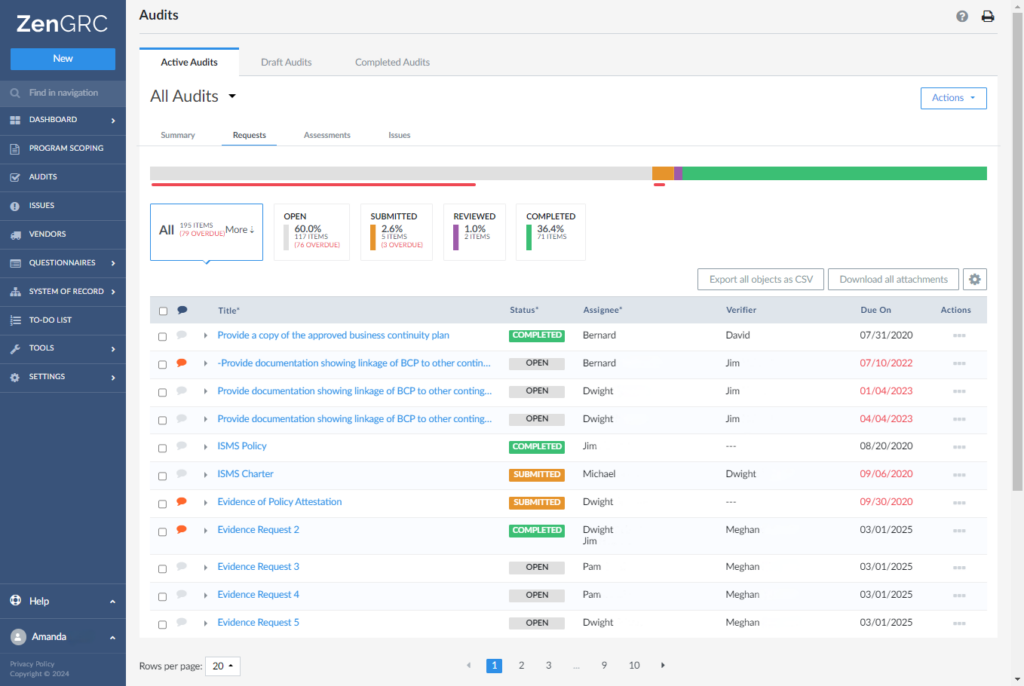Government
Protect Sensitive Data, Manage Risk, Gain Compliance
The Regulatory Burden
Security and compliance risks in the government sector are high. As an agency, you routinely collect personal data, such as name, address and age. If you accept payments from the public, you also collect credit card or bank account information. Health agencies may obtain medical records.
What’s more, you also have security risks simply because of the sensitive information you possess: intelligence data, threat assessments, scientific research. Even if privacy and breach disclosure regulations don’t apply, you still have high operational security risks due to the data they store.
Government agencies need a flexible compliance solution that allows you to find the optimal compliance and risk management program for the unique needs and scope of your business.
In May 2021, the White House issued an Executive Order on “Improving the Nation’s Cybersecurity” to protect the public sector, the private sector, and ultimately the American people’s security and privacy. The executive order deemed “the prevention, detection, assessment, and remediation of cyber incidents is a top priority and essential to national and economic security.”
Government agencies need a flexible risk and compliance solution that allows you to stay ahead of threats, meet compliance obligations and better secure your data, systems and assets.
A Framework for Information Security Success
All the data collected and stored by government agencies is subject to protection from multiple laws including:
- FedRAMP
- HIPAA (health information)
- The Gramm-Leach-Bliley Act (financial information)
- State breach disclosure laws (other personal information)
- GDPR if you collect personal data about EU citizens
Additionally, government agencies can enlist the help of cybersecurity frameworks like the Cybersecurity Maturity Model Certification (CMMC) or the NIST Cybersecurity Framework to help you protect your sensitive data and meet your various compliance requirements.
However, doing this manually through spreadsheets and other legacy tools can quickly become unmanageable, not to mention, prone to inaccuracies that are simply not permissible for a government agency.

Manage Compliance and Risk with Confidence and Ease
ZenGRC is a risk and compliance management solution that offers a cost-effective, integrated way to meet risk and compliance objectives across numerous, complicated risk management and security standards.
With compliance and security frameworks built-in and maintained by experts along with suggested risk and threat scores and real-time connections between control assessments and risk scoring, you get a unified, real-time view of risk and compliance and significant efficiency gains so that you can stay ahead of threats, reduce risk and strengthen compliance.
ZenGRC also unifies risk management, cybersecurity and compliance activities in a single platform, breaking down the silos that cause inefficiencies and delivering a trusted, single source of truth.
Compliance Objectives
Government agencies work with multiple frameworks to achieve their compliance and security objectives. For example, NIST 800-53 helps agencies assess the data security protocols they need while NIST 800-171 does the same for government contractors that handle “confidential, unclassified information.”
More “traditional” data can also be secured with other frameworks. Credit card data can fall under the PCI DSS framework. Health information is governed by the HIPAA Security Rule, which now maps to the NIST frameworks.
However, with so many different types of data, along with other unique risks, such as cybersecurity vulnerabilities, managing a compliance and risk management program manually through spreadsheets is simply unrealistic. With ZenGRC, you can:
- Assess vulnerabilities in your IT systems and network
- Study data collection practices for non-compliant behaviors
- Remediate any weaknesses, either through security patches to software or through changes to data collection practices
- Map progress on those remediation efforts
- Be prepared to report those risk assessments and remediations to other parties as necessary
- Integrate new threat alerts or updated regulations into your compliance program as they come along
FAQs for Government Industry
What are the steps to becoming CMMC compliant?
- Engage with the DoD
- Establish a procurement account and obtain and active status
- Conduct a self-assessment
- Understand the scope of the assessment
- Develop a plan
- Submit your assessment scope
- Demonstrate CMMC readiness and remediation
- Get a C3PAO assessment
- Pass (or fail) certification
Who needs FedRAMP Certification?
If you’re a cloud service provider (CSP) that plans to work with the federal government or a federal agency, you need to obtain FedRAMP certification. Without FedRAMP certification, cloud providers wouldn’t be eligible to obtain federal contracts.
While the time and cost investment of obtaining FedRAMP authorization may cause hesitation, you’ll find the investment well worth it when you realize that a single ATO can unlock the opportunity to work with multiple agencies.
Who should use NIST?
If you answer yes to any of the following questions, utilizing NIST standards to help you achieve your compliance objectives may be a good idea:
- Do you handle data protected by HIPAA?
- Do you routinely manage controlled, unclassified information?
- Do you have many third-party vendors and contractors?
- Will you ever compete for a contract with the U.S. government some day in the future?
- Do you hope to enter the national security business, either as a service provider or a small business contractor?
- Do you perform any work that must be compliant with the Federal Information Security Management Act (FISMA)?
